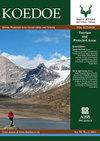第一个使用无人机调查非洲象(Loxodonta africana)的指导方针和建议的最佳协议
IF 1.1
4区 环境科学与生态学
Q3 BIODIVERSITY CONSERVATION
引用次数: 5
摘要
野生动物科学通常侧重于动物及其栖息地的研究、监测和管理(Chabot & Bird 2015)。虽然这些目标可能相对简单,但实现它们可能极具挑战性,特别是因为资源通常有限,目标物种可能难以捉摸,范围广泛,对人为干扰敏感和/或接近危险(Chabot & Bird 2015)。此外,许多目标动物的栖息地广泛、偏远,往往无法在地面上进入。新技术极大地帮助人们在充满挑战的栖息地了解这些困难的主题。例子包括运动触发相机陷阱(O 'Connell, Nichols & Karanth 2011)、飞机(Fleming & Tracey 2008)、遥感卫星(Kerr & Ostrovsky 2003)、雷达(Larkin 2005)、热像仪(O 'Neil et al. 2005)、基于弹射的动物捕捉装置和化学固定剂(Roffe, Sweeney & Aune 2005;Schemnitz 2005)和大量的电子跟踪设备和配套软件(Thomas, Holland & Minot 2011)。一种迅速普及的技术是被称为无人驾驶飞机系统(UAS)、无人驾驶飞行器(UAV)、遥控飞机系统或(最受欢迎的)无人机的空中单位。从许多调查无人机在遥感、自然资源科学和生态学中的应用和扩散的综述文章中,可以清楚地看出无人机在野生生物学家、生态学家和保护主义者中的普及程度(Allan et al. 2015;Anderson & Gaston 2013;Christie et al. 2016;Colomina & Molina 2014;Jones, Pearlstine & Percival 2006;Koh & Wich 2012;Pajares 2015;Shahbazi, Theau & Menard 2014;Watts, Ambrosia & Hinkley 2012;Whitehead & Hugenholtz 2014;Whitehead et al. 2014)。Chabot和Bird(2015)对无人机在野生动物管理中的使用进行了广泛的回顾,其中他们强调了动物的光学测量和观察,无人机在自主野生动物遥测跟踪,栖息地研究和监测中的使用,以及无人机的更广泛潜力的回顾。尽管能力和无人机,通常被称为无人机,越来越多地用于生态管理,保护和研究。许多关于无人机的评论都吹捧无人机在野生动物科学领域几乎具有无限的潜力,因为它们为人们开辟了难以进入的栖息地。然而,人们对无人机对动物本身的影响知之甚少,迫切需要通过影响研究来构建最佳实践方案,以尽量减少对目标物种的潜在压力。四轴飞行器的接近速度、接近角度和初始起始高度对非洲象(Loxodonta africana)的行为反应以及持续速度和飞行模式的影响进行了测试。共进行了79次进近飞行和70次抵达飞行。接近的速度和角度对飞行的成功有显著影响,但速度和飞行模式对大象在持续飞行中的行为都没有任何可测量的影响。建议在距离大象或象群100米的距离发射无人机,以接近速度为2m/s,接近角度为45°或更小,上升到50米的高度,成功接触大象目标。本文章由计算机程序翻译,如有差异,请以英文原文为准。
First guidelines and suggested best protocol for surveying African elephants (Loxodonta africana) using a drone
Wildlife science usually focusses on the study, monitoring and management of animals and their habitats (Chabot & Bird 2015). Although these goals may be relatively simple, achieving them can be extremely challenging, particularly as resources are often limited and target species can be elusive, wide-ranging, sensitive to anthropogenic disturbances and/or dangerous to approach (Chabot & Bird 2015). Additionally, many target animals occupy habitats that are extensive, remote and often impossible to access at ground-level. New technologies have greatly aided accessing these difficult subjects in their challenging habitats. Examples include motion-triggered camera traps (O’Connell, Nichols & Karanth 2011), aircraft (Fleming & Tracey 2008), remote sensing satellites (Kerr & Ostrovsky 2003), radar (Larkin 2005), thermal cameras (O’Neil et al. 2005), projectile-based animal-capturing devices and chemical immobilisation agents (Roffe, Sweeney & Aune 2005; Schemnitz 2005) and a vast array of electronic tracking devices and accompanying software (Thomas, Holland & Minot 2011). One technology that is rapidly gaining popularity are the aerial units known variously as unmanned aircraft systems (UAS), unmanned aerial vehicles (UAV), remotely piloted aircraft systems or (mostly popularly) drones. The popularity of drones amongst wildlife biologists, ecologists and conservationists is clear from the many review articles investigating the applications and proliferation of drone use in remote sensing, natural resource sciences and ecology (Allan et al. 2015; Anderson & Gaston 2013; Christie et al. 2016; Colomina & Molina 2014; Jones, Pearlstine & Percival 2006; Koh & Wich 2012; Pajares 2015; Shahbazi, Theau & Menard 2014; Watts, Ambrosia & Hinkley 2012; Whitehead & Hugenholtz 2014; Whitehead et al. 2014). Chabot and Bird (2015) conducted an extensive review of drone use in wildlife management in which they highlighted optical surveying and observation of animals, uses of drones in autonomous wildlife telemetry tracking, habitat research and monitoring and a review of the broader potential for UAVs. Although the capabilities and Unmanned aerial vehicles, commonly known as drones, are increasingly used in ecological management, conservation and research. Numerous reviews on drones tout almost unlimited potential within the wildlife sciences as they open up inaccessible habitats to observation. However, the influence of drones on the animals themselves is far less understood, and impact studies to construct protocols for best practices are urgently needed to minimise the potential for stress on target species. The impact of a quadcopter drone’s approach speed, angle of approach and initial starting altitude was tested on the behavioural responses of African elephants (Loxodonta africana), along with sustained speed and flight pattern. Seventy-nine approach flights and 70 presence flights were conducted. The speed and angle of approach significantly impacted the success of a flight, but neither speed nor flight pattern had any measurable impact on elephants’ behaviour during sustained flights. It is recommended that drones be launched at a distance of 100 m from an elephant or a herd of elephants, ascending to a height of 50 m by using an approach speed of 2m/s and an approach angle of 45 ° or less to successfully contact elephant targets.
求助全文
通过发布文献求助,成功后即可免费获取论文全文。
去求助
来源期刊

Koedoe
BIODIVERSITY CONSERVATION-
CiteScore
3.30
自引率
0.00%
发文量
10
审稿时长
20 weeks
期刊介绍:
Koedoe, with the subtitle ''African Protected Area Conservation and Science'', promotes and contributes to the scientific (biological) and environmental (ecological and biodiversity) conservation practices of Africa by defining the key disciplines that will ensure the existence of a wide variety of plant and animal species in their natural environments (biological diversity) in Africa.
 求助内容:
求助内容: 应助结果提醒方式:
应助结果提醒方式:


